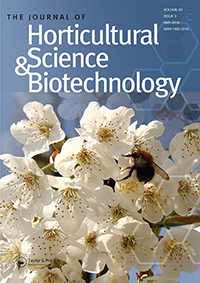Ver ítem
- xmlui.general.dspace_homeCentros Regionales y EEAsCentro Regional Mendoza - San JuanEEA La ConsultaArtículos científicosxmlui.ArtifactBrowser.ItemViewer.trail
- Inicio
- Centros Regionales y EEAs
- Centro Regional Mendoza - San Juan
- EEA La Consulta
- Artículos científicos
- Ver ítem
Effects of combined or single exogenous auxin and/or cytokinin applications on growth and leaf area development in Epipremnum aureum
Resumen
We have analysed the effects of combined auxin and cytokinin treatments on whole plant growth and leaf development in Epipremnum aureum and compared both morphological and physiological variables to those obtained with a single hormone application. Rooted cuttings of E. aureum were sprayed with 0, 5, 50, or 100 mg I−1 indole-3- acetic acid (IAA) 7 d after transplanting. One week later, they were then sprayed with 0, 5, 50, or 100 mg I−1 benzylaminopurine
[ver mas...]
We have analysed the effects of combined auxin and cytokinin treatments on whole plant growth and leaf development in Epipremnum aureum and compared both morphological and physiological variables to those obtained with a single hormone application. Rooted cuttings of E. aureum were sprayed with 0, 5, 50, or 100 mg I−1 indole-3- acetic acid (IAA) 7 d after transplanting. One week later, they were then sprayed with 0, 5, 50, or 100 mg I−1 benzylaminopurine (BAP). Whole plant growth, leaf development, carbon fixation, and leaf anatomy were recorded for 6 months after these sequential treatments. Following a single application of IAA or BAP, we observed an increase in the accumulation of whole-plant biomass, which reached a plateau at the highest concentration of either plant hormone. The promotion of growth was associated with increased rates of net C-assimilation and net photosynthesis, as well as with increased leaf thickness and the relative proportion of intracellular spaces in the mesophyll layer. The effect on leaves of applying both hormones, in different combinations and concentrations, resembled the results on whole plants obtained by spraying either the auxin or the cytokinin (at 50 or 100 mg I−1 BAP). Similarities in plant and leaf responses to the auxin and/or the cytokinin suggest that both hormones may act via the same pathway, which agreed with the well-known promotional effect of auxins on the development of new lateral roots, as root apices are the main site of cytokinin biosynthesis. Conversely, our results did not support the occurrence of a significant auxin-driven inhibition of cytokinin synthesis in root apices, at least for E. aureum, as reported in other species.
[Cerrar]

Autor
Di Benedetto, Adalberto;
Galmarini, Claudio Romulo;
Tognetti, Jorge;
Fuente
Journal of horticultural science and biotechnology 90 (6) : 643-654. (2015)
Fecha
2015
ISSN
1462-0316
2380-4084
2380-4084
Formato
pdf
Tipo de documento
artículo
Palabras Claves
Derechos de acceso
Restringido
 Excepto donde se diga explicitamente, este item se publica bajo la siguiente descripción: Creative Commons Attribution-NonCommercial-ShareAlike 2.5 Unported (CC BY-NC-SA 2.5)
Excepto donde se diga explicitamente, este item se publica bajo la siguiente descripción: Creative Commons Attribution-NonCommercial-ShareAlike 2.5 Unported (CC BY-NC-SA 2.5)

